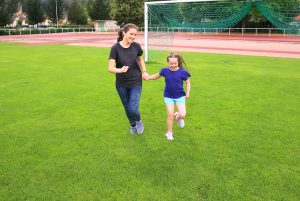 Think back to a time when children had fewer choices; when we had fewer choices. You could not sit on the couch and watch YouTube videos on your iPad or play video games with someone you’ve never met on X-Box. Fewer options to stay inside meant more choices to play outdoors and be active. It is a challenge to get children up and active these days. In this article, you will find strategies to keep children active along with a basic understanding of how to know if a child is healthy.
Think back to a time when children had fewer choices; when we had fewer choices. You could not sit on the couch and watch YouTube videos on your iPad or play video games with someone you’ve never met on X-Box. Fewer options to stay inside meant more choices to play outdoors and be active. It is a challenge to get children up and active these days. In this article, you will find strategies to keep children active along with a basic understanding of how to know if a child is healthy.
The Truth
Every child needs at least 60 minutes of good old exercise a day. If children are not sweaty and slightly stinky when they come back inside… then it doesn’t count. For children and teens (that’s anyone between 6 and 17 years), their goal should be: 60 minutes a day at least 5 days a week. As an alternative, you can have children count their daily activity steps using a pedometer (girls’ goal: 11,000; boys’ goal: 13,000). A pedometer is a fun way to have children get involved with their own health in an interactive way. Pediatric and Science Medicine found that less than 25% of student athletes receive the recommended 60 minutes of daily exercise. Just because children are part of an organized sport and attend practice daily, does not mean they are meeting recommended standards. Researchers have found that children spend more than 30 minutes of their practice being completely inactive while listening to instruction, learning skills which require little to no aerobic activity or simply waiting their turn. While coaches need to make sure every child is participating in the game, it is the ultimate role of a parent or loved one to see that their child is getting the daily recommended exercise. Do not assume. Know the truth. If your child is competitive and seeks a challenge, visit www.presidentschallenge.org(1) This site is a great way for adults to get involved in “physical challenges” at home. Rather than performing activities in a team setting, these can be done among siblings and/or family members. It can be a great addition to organized sports.
The Basics
A pound of body fat is equal to approximately 3500 calories. So if you have a diet deficit of 500 calories (meaning that you burn 500 calories more than you eat each day) you would lose approximately one pound per week:
500 × 7 = 35,000
It’s easy to see that a diet deficit of 1000 calories would mean that you would lose approximately two pounds per week. That is a good number to remember, because two pounds a week is commonly accepted as the maximum “healthy” rate of weight loss. This knowledge is for our eyes only. Our job is to educate ourselves and implement what we know in a healthy, nurturing way. Find out how many calories your child’s body needs if he or she simply stayed in bed all day – their Basal Metabolic Rate (BMR). Keep track of the calories your child consumes and how many calories they expend. With these three numbers, you can figure out how to lose or maintain a healthy weight. Now that we know the basics, let’s get started.
Keep it Fun
Get involved. Engage with children. Children learn best by watching, not telling. Forget the phrase, “Keep your eye on the ball.” Chances are they have no idea what you are talking about. Roll up your sleeves and show them how it’s done. For the younger ones, make it fun. Don’t worry too much about the rules. Making a game too rigid with lots of rules almost always guarantees children will stop playing and lose interest. If they walk away, you may not get them back. If children start goofing off or start chasing a butterfly…let them. Running, jumping and having fun is what keeps children active. If children are active they are building healthy pathways for a lifetime of good habits.
Do as I Do
 Be a great role model. You don’t have to be perfect or even look the part. Children are way less critical than their bigger more mature versions… you know, your adult aged friends! If children see you making the effort, they will do the same. You will send the message that exercise and outdoor activity is healthy. Make plans for everyone to get involved. Schedule weekend hikes or park outings for a game of tag or old fashioned hide and go seek! Chances are the children will not even realize they are exercising and you’ll be reminiscing about your own childhood memories. Remember, these are your children. They only know what you teach them. When arriving home from a family outing, have a mandatory 10-15 minute play session before everyone disappears to their room. Everyone will benefit from the fresh air, time together and an elevated heart rate.
Be a great role model. You don’t have to be perfect or even look the part. Children are way less critical than their bigger more mature versions… you know, your adult aged friends! If children see you making the effort, they will do the same. You will send the message that exercise and outdoor activity is healthy. Make plans for everyone to get involved. Schedule weekend hikes or park outings for a game of tag or old fashioned hide and go seek! Chances are the children will not even realize they are exercising and you’ll be reminiscing about your own childhood memories. Remember, these are your children. They only know what you teach them. When arriving home from a family outing, have a mandatory 10-15 minute play session before everyone disappears to their room. Everyone will benefit from the fresh air, time together and an elevated heart rate.
Unplug… unless you’re playing Wii
Studies from the American Heart Association and the Journal of Pediatrics officially state that Wii Fit and Wii Sports games are legitimate ways to stay active(2). However, recent studies show that children given the choice to play interactive Wii games in the real world versus a lab where the tests were conducted were less likely to play the game stating too many distractions. If the distraction is the great outdoors, fabulous; if the distraction is their favorite TV show, not so fabulous. At the end of the day, getting up and out is the best scenario. A study conducted by ACE (American Council on Exercise) teaches us that sports played traditionally are still the best way to stay fit (3). For example, the calorie expenditure of the Wii golf game is approximately 3-3.5 calories per minute. When actually going outside, hitting the ball and walking around the green burns approximately 6-6.5 calories per minute; twice the amount of Wii. Likewise, a non competitive game of tennis burns approximately eight calories per minute, while Wii tennis burns only five calories. The study concluded that boxing was the best bang for your caloric buck at seven calories burned per minute. When compared to actual sparring that burned 10-10.5 per minute, it still pays to get in the ring. Thirty minutes of Wii boxing burns an average 210 calories and running outside for 30 minutes burns about 50% more calories. If the seasons keep the children indoors, Wii is a great alternative for staying active during the colder months. When the ground thaws, hit the grass running!
Buddy system
Grab a buddy. Children living in neighborhoods with playmates are two to three times more likely to be physically active than those who don’t live near a friend. If you can’t send the children outdoors to play with friends, then plan for it. Make a play date. It will be a win for everyone. Take the children to a park where they can have play time with their friends and make new memories. While you have some time to read your favorite book or plan your week’s activities. Don’t forget the soccer ball…children love to run and it’s the best form of exercise you can do at the park. Want more? Plan a weekend hike with friends. Children love to share their adventures. Gather a small group of buddies and meet at a trailhead. Have the children wear a camelback hydration pack, so they can carry their own water and snacks. Create a scavenger hunt list the night before and hand each child a list. Keeping it fun is key. Engage them and they won’t even know they’ve just climbed 2000 feet to the summit. For every 1000 feet the children climb, their bodies will feel like they have walked an additional mile due to the energy they’ve expended. You can thank me at bedtime!
The bottom line
Children just want to have fun! Get creative and engage them in different activities. Activities do not have to be organized sports like basketball, softball, soccer or track. Afternoons of chasing an elusive frog, hide and seek, tag, or jumping rope are all fun ways to keep moving. Need more ideas? Visit wired.com/geekdad/2009/08/simpleoutdoorplay for great outdoor games for everyone. Be sure to keep the caloric count to yourself. Children don’t need to be counting calories. Educate yourself and implement your knowledge in a fun way. Creating healthy lifestyle habits for children is the best gift you can give them. Now get outside and get moving.
By Erica Gratton. Originally printed on the NCCPT blog. Reprinted with permission by NCCPT.
The National Council for Certified Personal Trainers (NCCPT) has been certifying health and fitness professionals for over 20 years. NCCPT is an MFN business partner.
References
The Presidents Challenge – presidentschallenge.org
American Heart Association –heart.org
ACE –acefitness.org
Wired –wired.com
